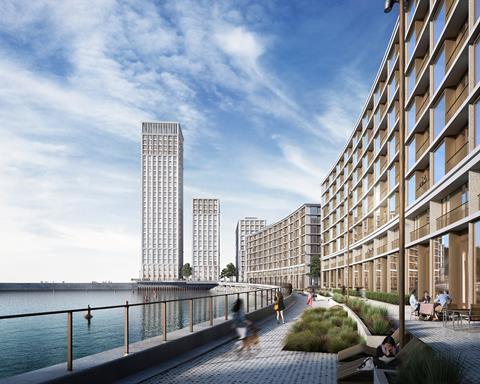Housing secretary criticises design of 1,000-home Brighton Marina project

Michael Gove has turned down plans for a 1,000-home redevelopment of Brighton Marina after concluding its “homogenous” design was not good enough for such a landmark site.
The housing secretary agreed with the inspector that the Outer Harbour scheme, designed by Squire & Partners for the Brighton Marina Company, should be turned down, arguing it “lacks the exuberance and ambition that the best of Brighton’s seaside buildings exhibit”.
Gove said the poor design would also impact on local grade I listed buildings, while the homes themselves would not provide sufficient outside space for residents.
He said these failures put it in conflict with policies in Brighton’s emerging plan and with national planning policy, and carried “significant weight” against the scheme.
Phase two would have seen 480 flats built across three buildings between nine and 28 storeys high while phase three would have included 520 flats in six buildings ranging from eight to 19 storeys high.
Gove’s decision comes despite the site having an existing permission for 835 homes and being allocated in the local plan. Brighton & Hove council also originally refused the scheme despite the council not being able to demonstrate the required five-year supply of housing sites.
It is the second major housing scheme situated in a council without a five-year supply of land that Gove has refused since taking up the housing secretary role in September, following his decision to refuse plans for 1,250 homes in Rainham, Kent last week. Both decisions have been in line with the recommendations made by the planning inspector.
He also rejected Foster & Partners’ Tulip last week, in line with his inspector’s recommendation.
The Brighton decision is likely to boost the fears of developers that recent changes to national planning policy over design will make it easier for councils to refuse schemes on allocated sites.

Gove’s decision said: “The Secretary of State considers that the negative aspects of the scheme in terms of its design, its impact on designated heritage assets, and the National Park, and its failure to provide acceptable living conditions for its residents outweigh the positive elements”.
The decision highlighted the “regularity of the façade treatments, and the homogenous mass that would be created, together with the failure to provide a proper landmark or bookend” to the site to explain the conclusion that the design was not of sufficient quality.
The decision added: “It would not, therefore, be a positive contributor to its context and in many respects, it would fail to take the great opportunity the appeal site presents.”
Brighton Marina and Squire & Partners declined to comment.
















2 Readers' comments